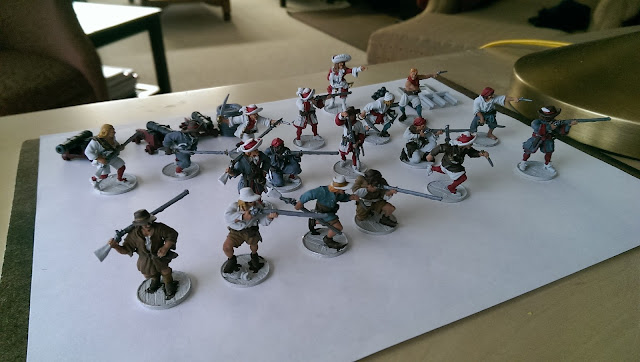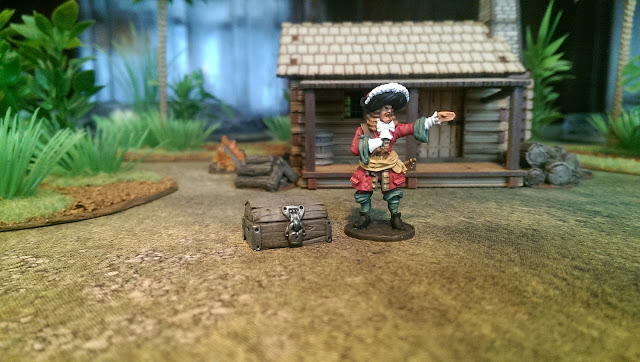J'ai pu enfin cette semaine, en parallèle de mon projet pour Blood & Plunder, terminer les dernières figurines pour mon armée de Britons pour Saga. L'ensemble est composé de figurines Footsore et Westwind productions.
Un peu d'histoire...
Brittany was known during the Roman period as Armorica. It was home to several Celtic tribes that largely lost their identity following conquest by Rome. But one of them did leave their name behind. The tribe of the Veneti had been the most powerful of Armorica's tribes, and that name gradually changed during the Roman occupation to Vannetais. It's the same name, but with a different suffix, and a shift in pronouncing the first vowel. The name had a transition stage during which it was referred to as Guenet by the Bretons. This name is precisely cognate to Gwynedd, with any perceived difference merely being down to different dialectal variants. Even the island of Belle-Île-en-Mer (ar Gerveur in Modern Breton, or Guedel in Old Breton) to the south of Brittany was known by the Romans as Vindilis, preserving the link to the Veneti.
This was how Armorica was initially known to the Britons who began migrating there in the fourth century AD, during a period in which British town life appears to have declined. Links established prior to the coming of Rome between south-western Britain and Armorica seem to have been maintained. The low-key migration from Britain into Armorica seems to have picked up noticeably in the mid-fourth century, but it became a flood in the unsettled fifth century. Traditional certainly maintains that the British colony in Armorica was founded before the expedition of Constantine III in 407. People arrived mainly from the south-west of Britain, from Dumnonia and Cornubia, and each group retained its ethnic name (ergo the people in each region knew exactly what they were ethnically or tribally, regardless of who was king over them).
FeatureThis new colony of Britons formed in a region that was beginning to drift out of firm Roman control. The colony's traditional first king, Conan Meriadog, ruled Armorica as the kingdom of Vannetais, maintaining the local Gaulish tribal name. The very fact that this has been claimed as a kingdom by multiple original sources certainly expresses a diminishing of Roman control over the region. The area was permanently 'freed' of Roman control by Magnus Maximus as the first stage of his invasion of Gaul in 383. Conan was placed in command, with a probable capital in Vannes. Although Brittany extended as far as Blois until 491, the land holdings outside its traditional borders are vaguely described, and may not even have been part of the kingdom's accepted territory.
The usual Celtic practice of dividing territory between sons soon created the smaller principalities out of Vannetais during the course of the fifth and sixth centuries whilst other Britons also popped over from the mainland to found their own principalities. The old name of Vannetais appears to have fallen out of use after its last remnant was renamed Bro Erech, and the colony's high kings simply termed themselves kings of the Bretons, or Brittany - the land of the Britons. Although the principalities of Bro Erech, Cornouaille, Domnonia, Leon and Poher, are mentioned often in Brittany, whenever the Bretons had dealings outside their borders only one king of the Bretons is mentioned. It seems highly likely that these many principalities operated on the same basis as their mainland British equivalents - petty kingdoms that vied with each other for power, but which acknowledged the strongest king amongst them as their representative in external affairs, and sometimes internal affairs too, when the interference warranted it. Britain itself had a well-established tradition of recognising a high king, and the later Anglo-Saxon invaders recognised the power of such a 'brand' by adopting their own format of it in the Bretwaldas.
From Kings of the Bretons (Vannetais / Britanni / Brittany).
Après avoir passé toute mon enfance en Bretagne, avoir écouté pendant des années des chants et des légendes sur l'origine de nos ancêtres et avoir lu des tonnes de livres sur le mythe arthurien (entre 2 Spirou et 3 ou 4 Astérix), cela aurait été un sacrilège pour une petit korrigan de ne pas commencer par les Britons comme première faction d'autant plus que je peux les jouer aussi bien dans l'île de Bretagne que sur le continent comme des Britons armoricains.
- Première couche
- Les plateaux de combat et les dés pour les Britons
- L'ours, le loup et le dragon rouge de Bretagne
- Les gardes à cheval
- Les druides sacrifiant une chèvre
- Des molosses reniflant l'arrivée des Saxons
- Des levées
- D'autres gardes à pied
- Merlin, le conseiller
- Les guerriers, unité 1
- Les guerriers, unité 2
- Les guerriers, unité 3
- Le mur de boucliers
- L'armée au complet




















































